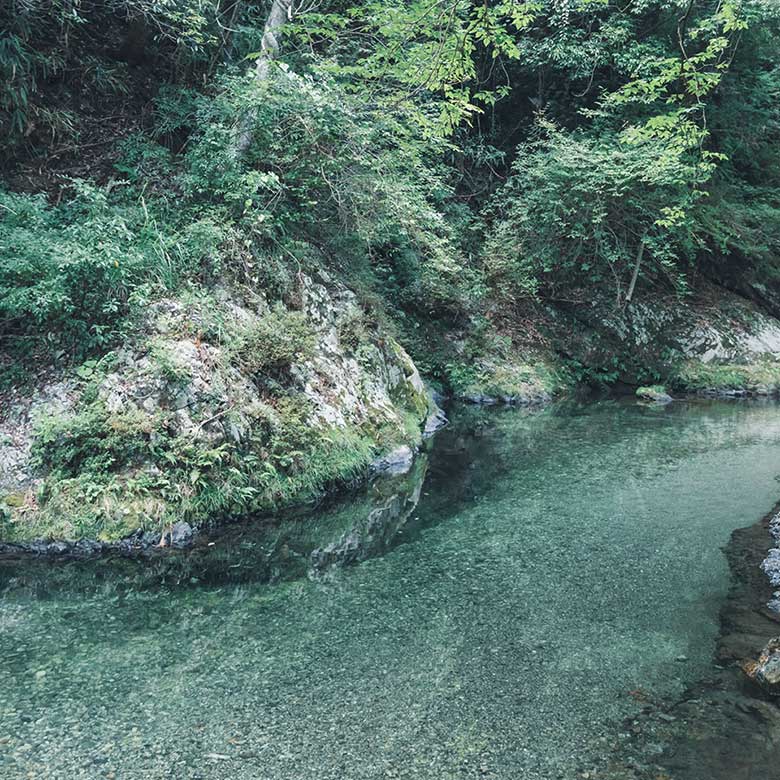

Nature of Okuyamato
The Nature of Okuyamato: Mountains, Clear Streams, and Man-Made Forests

A mountainous region where one can fully experience the changing seasons, and the tranquil highlands.
Rainfall from the sky seeps into the mountains, enriching the soil and nurturing the forests. Water springing from the mountains forms clear streams that support the lives of the people. The roots of trees spread throughout the mountains, preventing floods and landslides, protecting the lives in the valleys, and the harvested timber enriches people’s lives. This unbroken cycle of nature continues, with humans existing as a part of it in Okuyamato.
Especially in the southern part, there is a mystically deep mountainous area, with rugged rocky peaks, deep valleys, rapid streams, continuous waterfalls, and ancient trees, some over 400 years old, preserving untouched nature. It is also one of the rainiest regions in Japan, lush and dense with a variety of plant life. The abundant water supply makes this area the ‘water jar of Nara Prefecture,’ as it provides water to the entire prefecture through the Yoshino River.
Stream fishing is popular in the upper reaches of these clear streams. Amago trout farming is also thriving here, with the glittering fish visible in the water. Initially started as a post-retirement activity in forestry, trout farming has become an important job that supports village life and protects the river ecosystem. Recently, not just fishing enthusiasts but also people seeking clear streams are increasingly engaging in riverside camping, canoeing, and SUP (Stand Up Paddleboarding) activities.

Moreover, Yoshino is known as one of the best cherry blossom spots in the country, often referred to as ‘a thousand trees at a glance.’ In autumn, the trees in the mountains transform into a vibrant display of fall colors, and in winter, some areas even showcase frost-covered trees, allowing visitors to fully enjoy the changing seasons. The overall mild climate is a major draw, with comfortable and gentle weather that often makes air conditioning unnecessary even in the height of summer.
In the eastern region lies the ‘Yamato Plateau,’ a gentle highland area. The higher elevation of the highlands provides a cooler climate, ideal for cultivating highland vegetables and tea. Livestock farming is also prevalent, with the sight of sheep grazing being a common and tranquil scene unique to the highlands. The area offers a peaceful and open landscape typical of highland regions.

Growing, Using, and Nurturing the Highest Quality Timber to Protect the Forests
When talking about forests, there are both ‘natural forests’ left in their original state and ‘man-made forests’ created through human intervention. The Yoshino cedar and Yoshino cypress, known for their unparalleled beauty, come from man-made forests. Following the clearing of natural forests, the planting of cedar and cypress for their higher value as building materials began in the early Edo period. This practice has a history of about 500 years, making the Yoshino forestry one of the oldest man-made forests in the world.

The Yoshino forestry is characterized by a unique planting technique called ‘dense planting,’ not seen in other regions. Seedlings of cedar and cypress are planted at three to four times the density of typical afforestation. This is done to slow down the growth of the trees, narrowing the annual rings and straightening the grain. Regular pruning and thinning of underperforming trees are conducted every few decades. Over a period of about 100 years, the ‘best of the best’ trees are selectively left to grow. Though labor-intensive, this process results in high-quality timber with uniform ring width, strength, beautiful color, and fragrance.
The cycle of growing, using, and then regrowing and using the wood contributes to maintaining a healthy natural environment. Keeping the mountains healthy helps to preserve clean rivers and water and prevents natural disasters like landslides to some extent. Yoshino forestry is unique in its planning over a 100-year timeline, avoiding the complete harvesting of trees at once, which would otherwise lead to soil degradation and increased susceptibility to erosion. The trees planted today may not be seen in their full growth by the current generation, but they are planted with the future in mind, embodying the ethos of Yoshino forestry.
Established 500 years ago, the Yoshino forestry represents a sustainable system. Attracted by its long-term cyclical nature, an increasing number of young artists, woodworkers, and furniture craftsmen are moving to the area.”